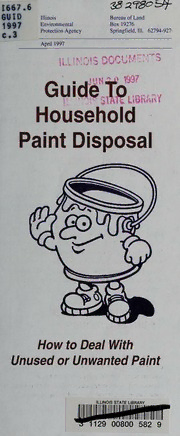
Guide to household paint disposal : how to deal with unused or unwanted paint PDF
Preview Guide to household paint disposal : how to deal with unused or unwanted paint
1667.6 GUID Illinois Bureau of Land 1997 Environmental Box 19276 Protection Agency Springfield, 111. 62794-927. C.3 April 1997 ooc'JM::r5 Household Paint Disposal How to Deal With Unused or Unwanted Paint ILLINOIS STATE LIBRARY 129 00800 582 9 RECOMMENDED METHODS FOR HOUSEHOt > Each year Illinoisans flush thousands of gallons of leftover or unwanted paints, solvents and thinners down their sinks and drains, and dump I thousands of gallons more into their trash cans. These actions can overwhelm \ sewage systems, destroy septic tanks, and damage landfills' protective barriers. The resulting contamination fouls surface and underground waters we all depend on for consumption and recreation. You can ease these threats > to human health and the environment by following a few simple steps: USE PAINT COMPLETELY Retailers reserve the right to limit quantities of leftover paint OR GIVE IT AWAY they will accept. Some may charge a small fee for this service. Others may accept paint returns only during certain hours or on certain days. Have your paint dealer help you estimate correct amounts for your project. Afterward, if some paint remains, apply A few enterprising Partners reformulate returned paint and sell additional coats to use it completely. resulting blends to homeowners or painting contractors, occasionally donating some reformulated paint to charitable If you have useful quantities of leftover paint, ask friends, organizations. Paints unsuitable for blending are consolidated neighbors or relatives if they can use it. Otherwise, donate for collection by waste-industry professionals. leftover paint to churches, animal shelters, housing authorities, theater groups or others who can use it. For the location of a Partners for Waste Paint Solutions store Recipients will appreciate your generosity even more nearest you, call 217-785-8604. when you give them paint in original containers having legible labels. HOUSEHOLD HAZARDOUS WASTE COLLECTIONS PARTNERS FOR WASTE PAINT SOLUTIONS If you’re unable to use, donate or return leftover paint, store it safely until you can take it to an Illinois EPA household In 1995, the Illinois EPA launched an innovative program hazardous-waste collection. The Agency conducts a number of called Partners for Waste Paint Solutions. Participating free collections statewide each spring and fall. To find out retailers accept leftover paint to help protect the when a household hazardous-waste collection will be coming environment. Some stores accept only latex (water-based) to your area, and what hazardous products besides paint are paint. Others accept both latex and oil-based paints. accepted, call 217-785-8604. PAINT DISPOSAL (If a collection has not been scheduled for your community, or for one nearby, urge your local officials to cosponsor future events. Ask them to contact the Agency's Waste Reduction Unit by calling 217-785-8604.) OTHER DISPOSAL OPTIONS Paints containing lead, cadmium or mercury are highly toxic and must be taken to a household hazardous- waste collection. Most other paints can be rendered safe for collection with your general refuse. Latex Paints Solidification is essential. Place open cans containing small amounts of latex paint in a well-ventilated area away from children and pets. Allow paint to dry thoroughly. Otherwise, mix paints with absorbents until solidified. Use kitty litter or commercial products intended for cleaning up oil spills. Place solidified paints with your weekly trash pickup, and recycle empty paint cans if possible. Oil-Based Paints Handle paints containing petroleum distillates with great care. They are ignitable and their fumes are potentially harmful. Always follow label directions. UNIVERSmr OF ILLINOIS-URBANA You can solidify oil-based paints 3 0112 122551499 by allowing their volatile GENERAL TIPS FOR HANDLING components to evaporate in a AND DISPOSING OF HOUSEHOLD well-ventilated area. Mix HAZARDOUS PRODUCTS remaining liquids with absorbents and allow to harden. Alternatively, apply leftover paint ✓ Buy only the quantities you need. to scrap lumber or cardboard. Keep children and pets away while these paints are drying. Then place these ✓ Keep products in their original containers. scraps with your regular trash. Store them according to label directions. Solvents Never pour paint thinners, turpentine, mineral spirits or ✓ Avoid skin contact and vapors. other solvents down any drain or sewer; never dump them on land or in any waterway. Donate unused products to others. ✓ NEVER mix different products. Violent chemical reactions may occur. You can “recycle” used solvents allowing paint pigments to settle to the bottom, and later pouring the ✓ If products exceed your needs, ask friends, clarified liquid into a new or neighbors, or charitable organizations if recycled (and accurately labeled) they want them. container. Mix the remaining solvent/paint sludge with an ✓ Always dispose of these products in an absorbent and dispose with your general refuse. approved manner, or take them to an For more information, contact: Illinois EPA household hazardous- Illinois EPA waste collection. Bureau of Land Solid Waste Management Section Box 19276 Springfield, Ill. 62794-9276 217-785-8604 Printed on recycled paper. Printed by Authority of the State of Illinois April 1997 27626 lOM
